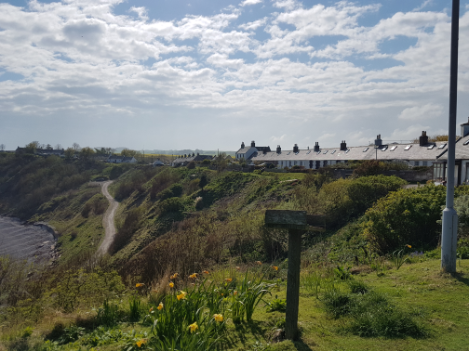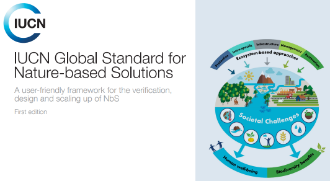Public acceptance of nature based solutions
Published: 5 February 2021
Using Catterline in Scotland as an example, Carl Anderson, phD student at the School of Interdisciplinary Studies, University of Glasgow, shares his thoughts on public acceptance of nature based flooding solutions and how critical this is.
Carl C. Anderson, University of Glasgow
A new friend of mine lives with his Scottish Terrier in one of a row of traditional white houses overlooking the North Sea. He has been high on a cliff above the water in the historic fishing village of Catterline for decades.
The entire area around Catterline is an official conservation area and some homes, including his, are officially listed as historic.
He feels safe here. He moved to Catterline to escape the bustle of the city, be a member of a small and tight-knit community, and most of all to be closer to nature.
The sound of the tide being pulled against the weather-worn rocks of the bay and the chatter of birds accompany him (and his dog) on their daily walks to the bay.

A view of homes next to the brae in Catterline. Photo credit: Dr. Karen Munro.
He enjoys the fresh salty air and shades of green on the surrounding cliffs as he gets exercise and does a bit of socialising – it’s no wonder the Scottish artist Joan Eardley chose this same scenery for some of her most celebrated work[1]. The benefits from nature (or ecosystem services) of Catterline are clear.
Unfortunately, these benefits are threatened by landslides. The Winter of 2012 brought massive waves crashing against the brae and rainwater flowing under the homes and through the porous soil out to the sea. More recently, intense and sustained rainfall in the region caused the tragic death of three people after a train was derailed due to a landslip outside the nearby town of Stonehaven in August 2020[2]. The same weather triggered further landslips in Catterline.
Roads in Catterline are often blocked by landslides, and these days my friend is increasingly concerned about property damage while insurance premiums increase.
My “friend” is emblematic of the many friendly residents I have met interacting with the community of Catterline as part of my ongoing PhD research.
As one site within the European Union funded OPERANDUM Project[3], nature-based solutions (NbS) are being deployed on the slopes of Catterline to reduce the risk of landslides. A range of measures using timber logs and vegetation as well as “live drains” with willow cuttings are to be implemented, coordinated by researchers at Glasgow Caledonian University. Not only do these natural measures help stabilise the brae, they also provide co-benefits so highly valued by many of the residents.
These efforts are positioned to bolster the already impressive organisation and determination of the community members who, after the landslides of 2012, came together to form an action group and address the issue[4].
However, not all communities have residents as engaged with natural hazard risk reduction as Catterline. Even in this tight-knit and proactive community, attitudes and behaviours toward the measures vary among residents and through time.
In the past decades, there has been a decentralisation of responsibility for disaster risk reduction and increased reliance on the public for successful measures (Bubeck et al. 2017; Kuhlicke et al. 2020)[5]. Because NbS involve living elements – in this case vegetation to stabilise the slopes – they require increased stewardship and protection.

The Sendai Framework for Disaster Risk Reduction 2015-2030 is an agreement among United Nations Member States that advocates an “all-of-society approach” to risk reduction, with concrete objectives for reducing the negative impacts of natural hazards.

The International Union for the Conservation of Nature (IUCN) recently published the Global Standard for NbS, which calls for inclusive nature-based solutions that promote local participation and the integration of local stakeholder knowledge.
But successful public participation requires a degree of public acceptance of the measures – active and meaningful engagement is not a foregone conclusion (Wamsler et al. 2019).
To better understand public acceptance of these measures and provide actionable recommendations for the many ongoing NbS projects around the world, I conducted a review of academic literature on the subject.
In it, my supervisor Fabrice Renaud and I compare NbS to traditional “grey” infrastructure to risk reduction (e.g., seawalls). Three main findings emerged:
- NbS are more reliant on the public for success and public acceptance is associated more strongly and with a wider range of positive outcomes.
- There are many factors that influence the public acceptance of these measures, including their perceived cost and effectiveness, the public’s degree of perceived risk, sense of responsibility, trust in the implementing body, connectedness to place and potential competing societal interests.
- Within the context of these factors, providing benefits, increasing awareness of benefits, communicating effectively, and promoting participation and collaboration are most frequently recommended for increasing public acceptance.

Synthesising results from the literature review, we create a framework – the Public Acceptance of Nature-based Solutions (PA-NbS) framework - as a starting point for researchers and practitioners to consider relevant criteria for increasing the likelihood of public acceptance and successful NbS. Each of the four primary recommendations has four success criteria that should be strived for when possible. Adapted from Anderson and Renaud (2021).
In Catterline, the importance of natural co-benefits (e.g., habitat creation and aesthetic beauty), connectedness to place, and risk perception are strongly related to public acceptance[1]. This information can help our project partners interact with the public by appropriately framing communication and ensuring that local values are taken on board. After all, the OPERANDUM project, like all projects, will be long outlasted by the local residents.
The public is composed of diverse stakeholders and NbS are as diverse as the hazards they are designed to address and places they are implemented. More research is needed within specific contexts for the continued global uptake of NbS and successful, long-term, and collaborative risk reduction.
Through my research I will continue to support the public engagement of local NbS stakeholders, including the residents of Catterline, who I look forward to once again visiting. Along with a certain Scottish Terrier.
For further information: https://www.gla.ac.uk/schools/interdisciplinary/postgraduateresearch/students/carlcyrusanderson/#publications
[1] https://www.nationalgalleries.org/art-and-artists/features/joan-eardley
[2] https://www.theguardian.com/uk-news/2020/aug/12/reports-of-serious-injuries-after-train-derails-scotland-stonehaven
[3] https://www.operandum-project.eu
[4] https://www.cbag.org.uk
[5] Also see Dr. Leslie Mabon’s recent blog post related to this topic: https://www.gla.ac.uk/research/az/ncr/blog/headline_758956_en.html
[6] Citizen surveys were conducted in the community in Autumn 2019. A manuscript for publication is currently being prepared with these findings.
References:
Anderson, C. C. and Renaud, F. G. 2021. A review of public acceptance of Nature-based Solutions: the ‘why’, ‘when’, and ‘how’ of success for disaster risk reduction measures. Material submitted for publication.
Bubeck, Philip, et al. "Explaining differences in flood management approaches in Europe and in the USA–a comparative analysis." Journal of Flood Risk Management 10.4 (2017): 436-445.
Kuhlicke, Christian, et al. "The behavioral turn in flood risk management, its assumptions and potential implications." Wiley Interdisciplinary Reviews: Water 7.3 (2020): e1418.
Wamsler, C., J. Alkan-Olsson, H. Bjӧrn, H. Falck, H. Hanson, T. Oskarsson, E. Simonsson, and F. Zelmerlow. 2019. Beyond participation: when citizen engagement leads to undesirable outcomes for nature-based solutions and climate change adaptation. Climatic Change. Springer: 1–20.
First published: 5 February 2021
<< Blog

